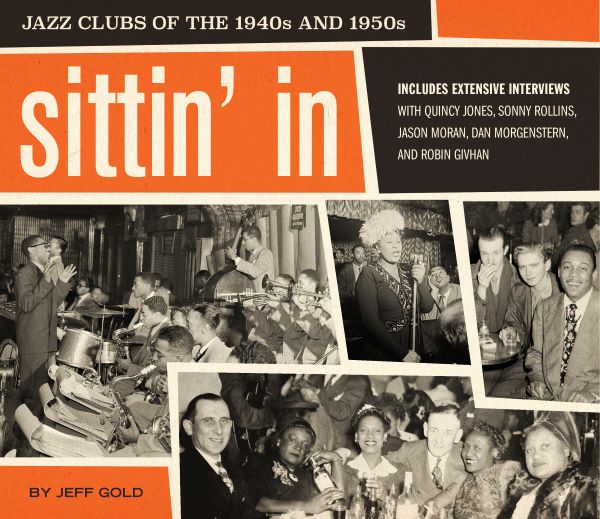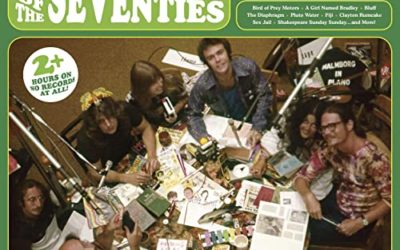By Harvey Kubernik Copyright 2020
In SITTIN’ IN: Jazz Clubs of the 1940s and 1950s (Harper Design; November 17, 2020), Grammy-winning historian, archivist, author, and record executive Jeff Gold offers an unprecedented look inside the jazz clubs from this era across the United States.
Drawing on an incredible trove of never-before-seen photos and memorabilia, he gives us a glimpse at a world that was rich in culture, music, dining, fashion, and more. In exclusive interviews, iconic musicians Sonny Rollins and Quincy Jones as well as preeminent jazz historian Dan Morgenstern give first-person accounts of the clubs that Rollins called “a paradisiacal place to be.”
Decades before Jackie Robinson broke baseball’s color barrier, jazz clubs were among the first places in Jim Crow America where Black and white people mixed in audiences and onstage. Rollins noted, “Jazz was really where the racial barriers were broken down heavily,” and Jones explained, “Back then, it wasn’t about color in the clubs, it was about how good you can play. Racism would’ve been over in the 1950s if they’d listened to the jazz guys.”
Additional interviews include jazz pianist and composer, MacArthur Fellow, and Kennedy Center creative director Jason Moran, who explores the history and culture of the music during the era, when bebop evolved from and in response to the big band swing sound.
Pulitzer Prize-winning fashion critic Robin Givhan discusses the abundant style of both club goers and musicians of the day in a social and sartorial context. Separate sections consider the jazz histories and clubs of New York City, Atlantic City, Washington DC, Boston, Cleveland, Detroit, Chicago, Kansas City, St. Louis, Los Angeles, and San Francisco.
The book’s 200 exclusive images include never-before-seen club souvenir photographs, some featuring fans posing with legendary musicians such as Charlie Parker, Duke Ellington, Dizzy Gillespie, Count Basie, and Louis Armstrong—and even one photo showing club–goer Marlon Brando with fans at New York’s Birdland. Also included is a wealth of colorful club graphics, from cards, menus, flyers, matchbooks, postcards, and posters as well as supplementary photographs of other top performers and venues of the day.
Revelatory and beautifully designed, SITTIN’ IN is a must-have for anybody interested in music, history, race relations, fashion, the music club scene, vintage photography, and little-known corners of American culture.
Jeff Gold is a Grammy Award winning music historian, archivist, author, and record executive.
He’s also appeared as a music memorabilia expert on PBS’s History Detectives and VH1’s Rock Collectors. Gold’s 2016 book, Total Chaos: The Story of The Stooges/As Told by Iggy Pop was one of Rough Trade’s “Books of the Year.”
His 2012 book 101 Essential Rock Records: The Golden Age of Vinyl, From The Beatles to the Sex Pistols was one of eight books selected by Rolling Stone as “The Year’s Best Reading Material.”
As Executive Vice President/General Manager of Warner Bros. Records, and a Vice President at A&M Record, Gold has worked with many artists across genres including Prince, The Red Hot Chili Peppers, R.E.M., The Police, Janet Jackson, Iggy Pop, and Cat Stevens. A four-time Grammy-nominated art director, Gold won the Best Album Package Grammy for Suzanne Vega’s Days of Open Hand in 1991.
I’ve known him since he was a teenager.
Follow him on Twitter and Instagram at @recordmecca, and on his website at recordmecca.com.
Harvey Kubernik and Jeff Gold Interview
Q: How did the concept for your book first begin? Were you approached or was it a commission?
A: In my business as a music archivist and dealer, I happened upon an amazing collection of souvenir photos from jazz clubs of the 1940s and 1950s. I’d never seen anything like them before. As I was buying them, I had the thought they’d make a great book, and that feeling just grew. I discovered there weren’t any books on jazz clubs, and these images were virtually unknown.
Q: How did you connect with the people you interviewed?
A: I wanted to speak to musicians who played these clubs during the forties and fifties, and my dream interviewees were Quincy Jones and Sonny Rollins. I met Quincy through music business connections and Sonny through his publicist. Through a friend I met Dan Morgenstern, the world’s foremost jazz historian, who began going to these clubs in 1947; he was the perfect person to get the audience member’s perspective from. I wanted to get the perspective of a younger musician with a historical bent, and met Jason Moran through another friend. And finally I wanted to talk to someone who could help analyze the photos, and wrote to my #1 choice, Robin Givhan, a Pulitzer Prize winning fashion critic, and she said yes!
Q: Was it always going to be a domestic view of music clubs and then politics were added to the narrative?
A: Initially the book was going to be built around the collection of souvenir photos from the clubs. In my first interview, with Quincy, I asked what the racial situation was like in the New York clubs of the late 40s, and was pretty surprised when he told me the clubs were kind of an oasis from racism, that everyone got along. When I spoke to Sonny, he amplified this and lamented that the important role jazz played with integration isn’t ever written about, telling me “I hope you put this in your book”. Those two interviews got me to explore race and politics much more deeply.
Q: Explain the pre-production process.
A: As I did the interviews, I found an agent and then sold the book to Harper Collins. I then had to choose which photographs and memorabilia to include, then we decided to organize it geographically, and began the editing process.
Q: Was it always going to be a whole slew of clubs and venues to get the complete picture of the US?
A: I chose a representative sampling of clubs across the country, but there were some cities, like Philadelphia, that had clubs, but I couldn’t find any souvenir photos or memorabilia from.
Q: Tell me about the steps of photo and artifact acquisition.
A: I was lucky enough to buy one large collection from someone who had been collecting these for more than thirty years; I supplemented it with things I found, was able to borrow from other collectors, and then obtained some other images from the Library of Congress and other places.
Q: Can you tout some of the mind blow items you located or the journey that led to them?
A: One of my favorite images is a souvenir photo from Birdland, in New York, picturing two couples posing with Marlon Brando, who just happened to be sitting in the audience. I found this in the collection I bought, and was pretty surprised when I recognized Brando. It’s kind of the primordial version of a celebrity selfie!
Q: How does the legal work happen with this sort of book? Rights holders and estates?
A: None of these images had copyright notices, and are 60+ years old and in the public domain, happily.
Q: Are they super receptive or are licensing fees involved?
A: The Library of Congress has an amazing collection of photographs by legendary jazz photographer William Gottlieb which are also in the public domain, so I was able to use a number of these; I also filled in a few holes licensing photos from Getty and Magnum.
Q: I know Jeff Gold KNOWS how to collect and so do I. Do you have a few insider tips or methods of securing post cards, match books, ads, menus and artifacts? Perhaps list the 1 or 2 treasures that emerged.
A: I look on Ebay daily, and it’s a needle-in-a-haystack situation, but if you keep looking, you’ll find things. One Ebay find used in the book is a souvenir photo from the 400 Restaurant in New York City, with Duke Ellington and actress Joan Davis posing with a soldier in 1945.
Q: Talk to me about dealing with photographers? Did you and team generate initial emails and general form of introducing the project? Who was really collaborative and helpful regarding photos? I would imagine when you are linked with Harper Collins and Quincy and Jason it is very helpful.
A: I did all the photo research and rights acquisition myself, but yes, having Harper Collins and the interviewee names attached did help.
Q: Talk to me about collaborating with Jason Moran and Robin Givan.
A: Jason is a brilliant musician and composer, but he’s also the creative director for jazz at the Kennedy Center and teaches at the New England Conservatory–and knows a ton about jazz history. He’s also a visual artist who had a one-man show at the Whitney Museum in New York last year, based on recreations of jazz club stages. So he was the perfect person to speak to about what a younger musician sees in these photographs. He was blown away, having never seen anything like them. Robin Givhan is the fashion critic at The Washington Post, but she’s an expert de–constructor of images. I pestered her repeatedly until she agreed to speak with me. And I’m’ glad I did.
Q: Discuss at length the interactions and interviews with Quincy Jones, Dan Morgenstern, Sonny Rollins and others.
A: I really felt it was critical to get eyewitness accounts of these clubs. I’d met Quincy during my record business days, and because of his vast experience, first as a musician, then as a producer, entrepreneur, visionary I worked hard to get him to say yes. Sonny Rollins is the most famous jazz musician alive, and also an extremely intelligent and thoughtful man. For obvious reasons they were my first choices, and they delivered big time. They have indelible memories of these clubs. Dan Morgenstern had an amazing story; he was a refugee from Nazi Germany, and arrived in New York in 1947 as a seventeen year old jazz fan, and immediately hit the clubs. They all snuck into these clubs before they were of age; Sonny using eyebrow pencil to draw in a moustache.
Q: How did you prepare for these specific interviews? I realize your topics were venues and fashion.
A: I read 40 books before I began writing and listened to or read many interviews with each of the people I spoke to. Then I emailed or sent them a selection of the souvenir photographs, which were a great jumping off point for each discussion. And of course I had many prepared questions.
Q: The role(s) of gender and racism are addressed in the book. We find out from Sonny and Quincy that segregation was not a factor in these clubs. It truly was about how good you played.
A: Yes, as I mentioned, Quincy was my first interview and I was surprised when he said that. It was an obvious thing to explore with the others I spoke to.
Q: I’ve worked with musician and producer David Kessel, son of legendary jazz guitarist Barney. His father played a lot of these clubs on Central Ave. in the late forties. There were white people like Barney were on the bandstand, and all sorts of celebs went to these clubs. Ava Gardner, Marlon Brando. No entourages with them. Did you notice how actors frequented clubs in their cities?
A: Absolutely, in the book I note that Orson Wells, Marilyn Monroe and Humphrey Bogart were frequently seen at LA clubs, and as above, we actually have a photo of Brando at Birdland.
Q: Tell me about the current climate of memorabilia? You have witnessed peaks and valleys. What genres and areas are hot now and what trends to you forecast. I am getting more interest than ever on sixties/Laurel Canyon music and ALWAYS about The Doors, David Bowie, Bob Dylan, The Rolling Stones, Jimi Hendrix and The Beatles.
A: Amazingly, the memorabilia market is strong, especially at the high end. In this Covid era, I think more people are online, looking for distraction or for something to buy to ease the pain a bit. That’s made finding things more difficult though.
Q: Owing to the vinyl and mono LP renaissance, collectors and memorabilia seekers seem to be looking further into the past and realizing how durable and cool the music and items of half a century or seventy years ago are?
A: I think nostalgia is of great comfort during trying times like this, but you’re asking someone who has long been obsessed with music and memorabilia from the past –so I’m not exactly objective. However vinyl sales, auction records and media coverage all indicated that I’m not alone.
Q: Tell me about the jazz market as far as collectibles. What have you noticed?
A: Though jazz has always had a smaller audience than rock or newer genres like hip hop, it’s always had a fervent audience. There are many people looking for items from the biggest names like John Coltrane, Charlie Parker, Miles Davis and Thelonious Monk. And prices for the best items are higher than ever.
Q: What have you learned from previous authored books that informed this book and tasks required?
A: My previous books, on classic vinyl and the Stooges, are, like this, deep dives into niche subjects– but niche subjects that have fanatic followings. I stick to subjects that obsess me personally; that way I’m fully engaged and the research is fun instead of a chore. As the old adage goes, do what you love.
Harvey Kubernik is the author of 19 books, including Canyon Of Dreams: The Magic And The Music Of Laurel Canyon and Turn Up The Radio! Rock, Pop and Roll In Los Angeles 1956-1972.
Sterling/Barnes and Noble in 2018 published Harvey and Kenneth Kubernik’s The Story Of The Band: From Big Pink To The Last Waltz. For 2021 they are writing a multi-narrative book on Jimi Hendrix for the same publisher.
Otherworld Cottage Industries in July 2020 has just published Harvey’s 508-page book, Docs That Rock, Music That Matters, featuring Kubernik interviews with D.A. Pennebaker, Albert Maysles, Murray Lerner, Morgan Neville, Sandra Warren, Michael Lindsay-Hogg, Andrew Loog Oldham, John Ridley, Curtis Hanson, Dick Clark, Travis Pike, Allan Arkush, and David Leaf, among others.
In 2020, Harvey Kubernik penned a back cover book jacket endorsement for author Michael Posner’s book on Leonard Cohen that Simon & Schuster, Canada, will be publishing October 2020, Leonard Cohen, Untold Stories: The Early Years).
During 2020 Harvey served as Consultant on Laurel Canyon: A Place In Time documentary directed by Alison Ellwood which debuted on May 2020 on the EPIX/MGM television channel.
Kubernik served as Consulting Producer on the 2010 singer-songwriter documentary, Troubadours directed by Morgan Neville. The film screened at the 2011 Sundance Film Festival in the documentary category. PBS-TV broadcast the movie in their American Masters series. During 2020-2021 Kubernik is working on an authorized documentary on singer/songwriter Del Shannon.
His writings are in several book anthologies, most notably The Rolling Stone Book Of The Beats and Drinking With Bukowski. Kubernik’s 1995 interview, Berry Gordy: A Conversation With Mr. Motown appears in The Pop, Rock & Soul Reader edited by David Brackett published in 2019 by Oxford University Press. Brackett is a Professor of Musicology in the Schulich School of Music at McGill University in Canada. Harvey joined a distinguished lineup which includes LeRoi Jones, Johnny Otis, Ellen Willis, Nat Hentoff, Jerry Wexler, Jim Delehant, Ralph J. Gleason, Greil Marcus, and Cameron Crowe.






